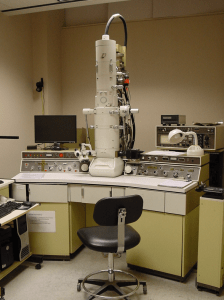
The JEOL 100CX II TEM is a traditional transmission electron microscope (TEM) with a tungsten filament. The tungsten electron source is heated to a high temperature, and the energized electrons escape the tungsten metal, are concentrated into a beam, and accelerated down the length of the TEM column.
As the electrons spiral down the column, they are focused by the magnetic field of the electromagnetic lenses and sent through the thin, 100 nm, sample. The magnified image of the specimen is formed on the fluorescent screen by the post-sample electromagnetic lenses of the column. This TEM is equipped with a side-entry goniometer and a side-mount digital camera.
This TEM is used to obtain routine-magnification transmitted electron images of materials, polymers and biological samples.
To reserve time or request training on this tool, click here to go to the JEOL 100CX-II TEM page on SUMS.
|
|
|
|





